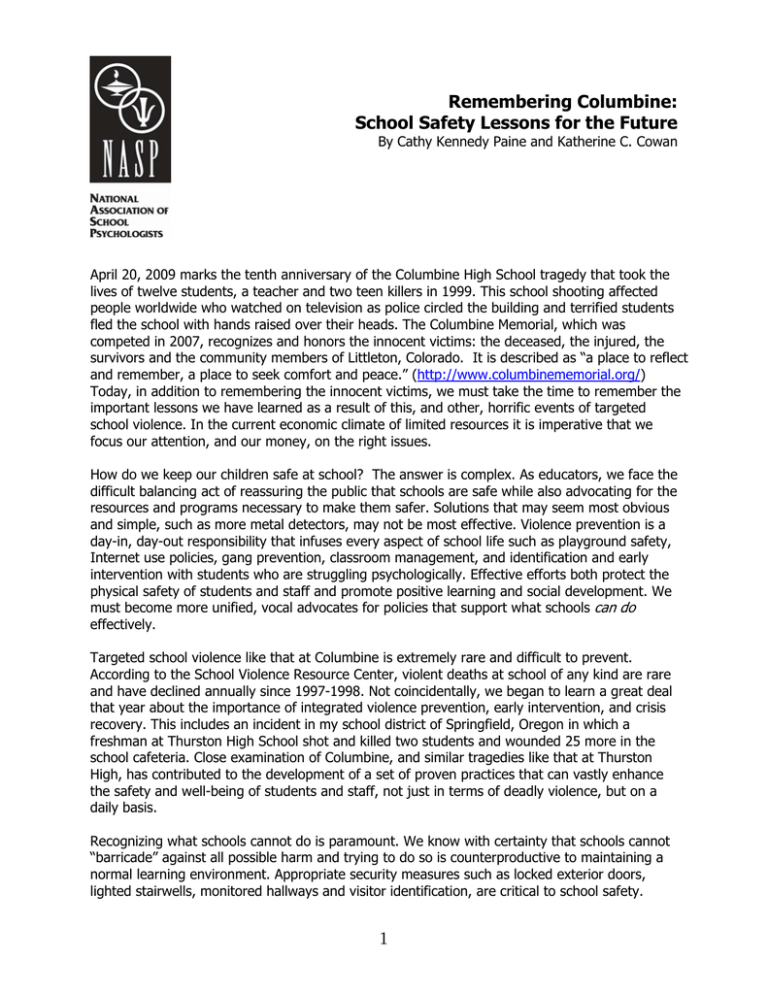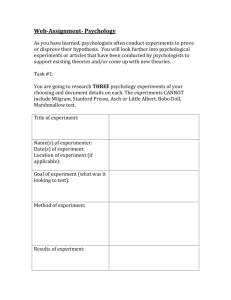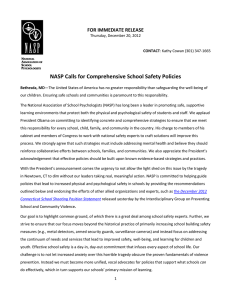Remembering Columbine: School Safety Lessons for the Future
advertisement

Remembering Columbine: School Safety Lessons for the Future By Cathy Kennedy Paine and Katherine C. Cowan April 20, 2009 marks the tenth anniversary of the Columbine High School tragedy that took the lives of twelve students, a teacher and two teen killers in 1999. This school shooting affected people worldwide who watched on television as police circled the building and terrified students fled the school with hands raised over their heads. The Columbine Memorial, which was competed in 2007, recognizes and honors the innocent victims: the deceased, the injured, the survivors and the community members of Littleton, Colorado. It is described as “a place to reflect and remember, a place to seek comfort and peace.” (http://www.columbinememorial.org/) Today, in addition to remembering the innocent victims, we must take the time to remember the important lessons we have learned as a result of this, and other, horrific events of targeted school violence. In the current economic climate of limited resources it is imperative that we focus our attention, and our money, on the right issues. How do we keep our children safe at school? The answer is complex. As educators, we face the difficult balancing act of reassuring the public that schools are safe while also advocating for the resources and programs necessary to make them safer. Solutions that may seem most obvious and simple, such as more metal detectors, may not be most effective. Violence prevention is a day-in, day-out responsibility that infuses every aspect of school life such as playground safety, Internet use policies, gang prevention, classroom management, and identification and early intervention with students who are struggling psychologically. Effective efforts both protect the physical safety of students and staff and promote positive learning and social development. We must become more unified, vocal advocates for policies that support what schools can do effectively. Targeted school violence like that at Columbine is extremely rare and difficult to prevent. According to the School Violence Resource Center, violent deaths at school of any kind are rare and have declined annually since 1997-1998. Not coincidentally, we began to learn a great deal that year about the importance of integrated violence prevention, early intervention, and crisis recovery. This includes an incident in my school district of Springfield, Oregon in which a freshman at Thurston High School shot and killed two students and wounded 25 more in the school cafeteria. Close examination of Columbine, and similar tragedies like that at Thurston High, has contributed to the development of a set of proven practices that can vastly enhance the safety and well-being of students and staff, not just in terms of deadly violence, but on a daily basis. Recognizing what schools cannot do is paramount. We know with certainty that schools cannot “barricade” against all possible harm and trying to do so is counterproductive to maintaining a normal learning environment. Appropriate security measures such as locked exterior doors, lighted stairwells, monitored hallways and visitor identification, are critical to school safety. 1 Excessive building security does not promote a genuine sense of student well-being nor does it provide a guarantee when an armed intruder is willing to die. Educators should concentrate on violence prevention strategies that are child-focused and support learning. We must balance building security with efforts that foster student resiliency, connectedness and social competency. It is here that school psychologists can have tremendous impact. The core principals are the same as those underlying sound educational policies and practices that address the quality of the learning environment and the needs of the whole child. Specifically schools should: • create welcoming, nurturing school climates; • enforce positive behavior and discipline for all students; • support student mental health and wellness; • develop and regularly review crisis and threat assessment plans; • train staff in crisis procedures and risk factors for violence; • maintain appropriate building security; • develop collaborative relationships with local law enforcement and community services • strengthen home-school connections. Central to this effort is helping students and their families feel valued and personally invested in keeping their school safe. This relates to codes of conduct, bullying prevention, conflict resolution, strategies that promote personal responsibility, respect and compassion, and developing trusting student-adult relationships in which students are encouraged to report potentially dangerous activity. Equally important is being able to respond to students in distress with appropriate mental health services. The importance of school-based mental health services is well documented, starting with the Report of the Surgeon General's Conference on Children's Mental Health: A National Action Agenda in 2000. Research shows that 20 percent of students will experience a mental health problem in the course of their school life. Whether fighting, driving drunk, selfharm, or suicide (the third leading cause of death among youth), these behaviors are all forms of violence that undermine student safety. School psychologists can provide a link between mental health supports and the learning environment, and teach prevention strategies such as problem solving and stress management skills. Staying focused on student needs and outcomes also makes our efforts more effective at the two extreme ends of the violence spectrum: threat assessment and crisis planning and recovery. Threat assessment is perhaps one of the most difficult areas in violence prevention because there is no single profile of a student who may pose a real threat and no assured way to predict if a student will become violent. However trained school mental health professionals like school psychologists can help assess the multiple factors that put a student at risk and work with other members of the crisis team and professionals in the community to provide appropriate interventions. Prevention is the goal but being prepared for the unpreventable is integral to school safety. We have seen time and again the pivotal role school psychologists and counselors play in the healing process after tragedies. The PREPaRE: School Crisis Prevention and Intervention Training Curriculum has been developed by the National Association of School Psychologists. It 2 provides evidence-based resources and training for school personnel in crisis preparation, prevention, interventions, response, and recovery procedures, with a special emphasis on the role of school-based mental health professionals. It is a cost-effective, school-based training that meets the specific needs of school staff. Moreover, it integrates with and enhances the three-tiered service delivery model that supports prevention and learning. In addition to actual training, the principles, components, and steps for implementing the PREPaRE are detailed in the new book, School Crisis Prevention and Intervention: The PREPaRE Model. As with most challenges in education, there is no single or simple solution to making our schools safe. It is a multi-faceted, ongoing effort that requires commitment and participation from all stakeholders, including federal and state lawmakers. Ironically, federal Safe and Drug Free Schools funds have declined to a fraction of their previous level at a time when they are needed most, as have grants for secondary and elementary school counseling programs. Any act of school violence is unacceptable; so too is failing to act with clarity and diligence on the lessons learned from Columbine and other tragedies, as well as our successes. The Columbine Anniversary offers an opportunity to make clear to policy makers, educators, and the public that we know what works; our challenge is to put that knowledge into universal, permanent practice. Cathy Paine is a school psychologist in Springfield, Oregon; director of the district’s Safe and Drug Free Schools program; member of the NASP National Emergency Assistance Team; and past chair of the Crisis Management in the Schools Interest Group of the National Association of School Psychologists (NASP). She was one of the invited panelists at the White House Summit on School Violence Prevention, on Tuesday October 10, 2006. Kathy Cowan is Director of Marketing and Communications for NASP. Adapted from an article originally printed in Education Week December 6, 2006. ©2009—National Association of School Psychologists – 4340 East West Highway, Suite 402, Bethesda, MD 20814, www.nasponline.org 3





